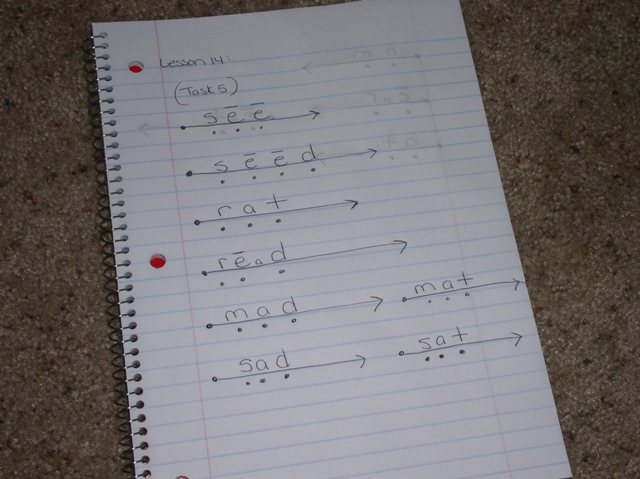Learning to Read **Making Progress**

Asalaam ‘Alaikum:
In the past I have mentioned having problems with using “Teaching Your Child to Read in 100 Easy Lessons.” I spoke recently with a friend who has used that program to teach all of her children. It seems she forgot to mention that at least one or more of her children had the same problem.
What was the problem? Essentially, my daughter had become flustered and frustrated when looking at all those words in the book. She then announced “I don’t like doing this and don’t want to do it anymore.” So, we put it on hold (for quite a long while). Well, my friend gave me a few ideas and they have actually worked, alhumdulilah. Essentially, my daughter still uses the book when working on the sounds, rhymes, etc. However, whenever we go over the “word reading” section, I take out a notebook and write the words (exactly as they are written in the book) for her one at a time as we go over them. For some reason, this doesn’t overwhelm her as much as seeing all those words already on the page.
We have done this for a few lessons and I am surprised at her abilities, masha’Allah. She is even now sometimes able to read a word without sounding it out – and she is learning the sounds better. Anyway, just thought I’d share this insight with you other mothers – if you are using this book – as it has been a frustrating time trying to find something else that would work (and I really like this book).
For those of you who actually use this book, you may notice that this lesson (above picture) includes some words that are not in the book (mat and sat, for example). During our lesson, my daughter kept making the mistake of pronouncing the ‘d’ sound as ‘t’ (even though when I asked her what sound the ‘d’ and ‘t’ made, she knew the difference. So, I decided to write out the other word that is similar, but sounded different to show her the difference visually and it seemed to help.
Essentially, we are still using Montessori methods as well. I have been following the “Montessori Read & Write” book by Lynne Lawrence and I do really recommend it. My daughter doesn’t seem to mind these short learning sessions with “How to Read in 100 Easy Lessons”, but she enjoys using the Montessori methods and will “play” with them for an extended period and consider it fun. Insha’Allah it will benefit her.
PS: A while ago I posted our Montessori based tool – similar to “Classified cards”. Please see here. Subhan’Allah, in my frazzled state of mind I made these previously all in capital letters without a thought. Thankfully, someone posted that they should be made in small letters – as this helps with letter recognition when reading (most letters are small case except the beginning of sentences, etc.) Anyway, I did fix this but never got around to posting the new pictures. So, for those of you who are interested, I have posted the new pictures here. I also wanted to mention that I actually made my new cards with the “Montessori font” that is available on the web for free download. I wish I could remember where I found it – but I am sure if you do a search on “Montessori font” you should eventually find one (if you are interested).
Asalaam ‘Alaikum,
Sumayyah Umm SAA





That is really interesting. Maybe she is very sensitive to sensory overload. I think my son is the same way. I use Phonics Pathways and somedays he just hates looking at the book but if I write on a white board he is eager to do his lessons. I might do that more often, it maybe there is too much on the page for him to focus.
Masha Allah your site is really great, I am definitely picking up some ideas that I want to implement.
Some of my children found the McGuffey;s readers easier to grasp than the 100 easy lessons.
You may want to try book one and see if they like the difference in approach. You should be able to find them for free online, they are in the public domain and go from grades k-6
Assalamu Alaikum
I taught my son to read with Jolly Phonics and then the Ladybird Peter and Jane books and I kept the process flexible, doing what I thought he needed work on rather than following a rigid step by step programme. He is 4 and can read pretty fluently ma sha Allah
As salamu alaykum,
I am so unconventional. I taught my children to read with no program but my own ideas and some help from the internet. I checked out their learning styles and attacked it from there. What they loved(our youngest child just started reading cvc words,the other two are 2yrs ahead of peers)is our fridge alphabet/word trains. I first taught them the letters and sounds through various games. Then I i used letter magnets to make a word train. I first placed the letters spaced apart from eachother and asked the child to say each letter and it’s sound. Then I asked to give me sound only. after that I asked if they can make a train by putting all the sounds together,first slow then saying them fast. They seemed to love this,espcially the boys who love crashing letters together fast to make their words.
Each child is different,so that must be taken into account. However almost all chidlren learn better through play than sitting at a desk staring a book full of words or at a white board for longer then 20 minutes.
Thats how young children are and there is nothing wrong with that.
thats why homeschooling is so great, you actually get to teach instead of instruct, who cares for instruction anyway?
I hope this makes sense. My point is, make learning exciting and things will be easier,in sha Allah.
Ok, back to my lesson prep….
as salamu alaykum!
assalamu alaykum sister, i found what john holt said helpful:
”i think the teaching of reading is mostly what prevents reading.”
i read many books to my daughter and answer her queries about the written word (what is this, how do i spell that etc.), and as such i don’t try to teach her reading itself…it may or may not take longer but i think it’ll in sha Allah preserve the joy of learning and build her confidence when she sees that she learnt it herself.
Yes, my child also found the “100 Lessons” overwhelming. Also, the recommended parent-child dialogue sounded stilted and artificial to us. So, while we used the letter-sounds and words in the book, we adapted the approach by making up rhyming words, making silly sentences with them. It worked a lot better.